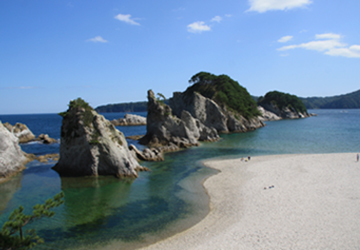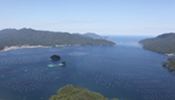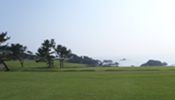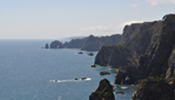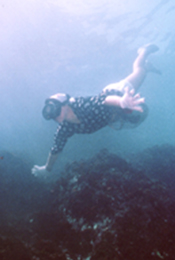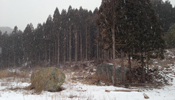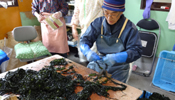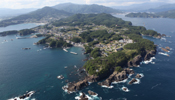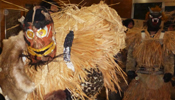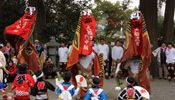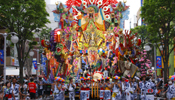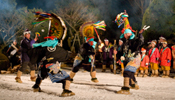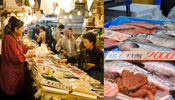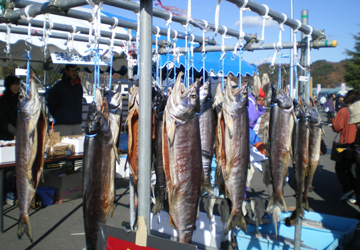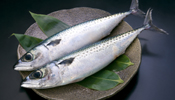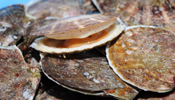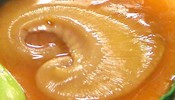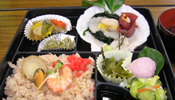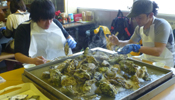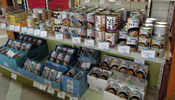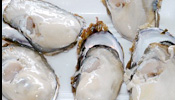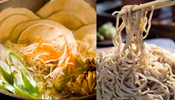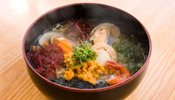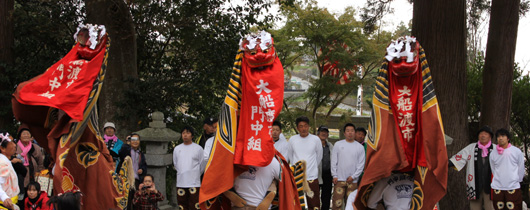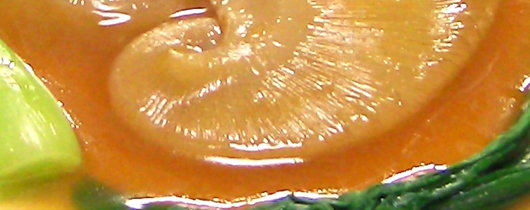 |
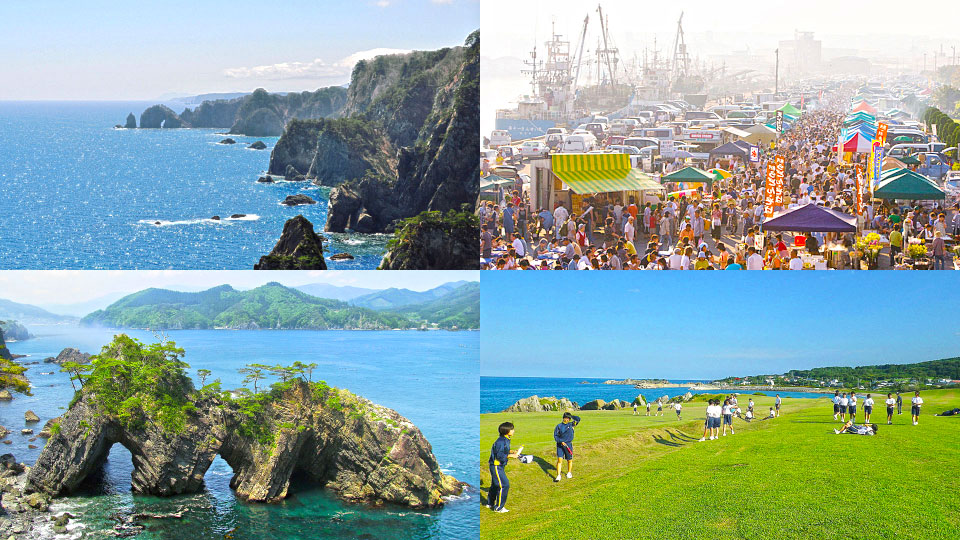 |
Tanesashi Beach
A stroll along Tanesashi Beach reveals magnificent sceneries of the one and only beach grass grassland in Japan. This unique scenery is formed by the meeting of cool, wet Yamase winds from the Okhotsk Sea and the coastal terrace landforms characteristic of this region.
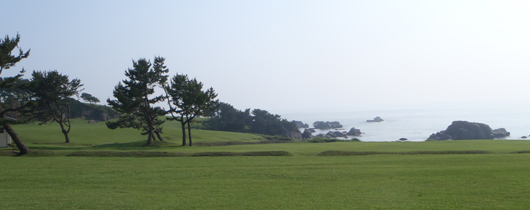
Kitayamazaki cliffs
The stunning 200-meter high Kitayamazaki cliffs were formed from wave erosion of upheaved earth crust stretching along the length of the coast. The sheer height and length makes this one of the most stunning sceneries in Japan.
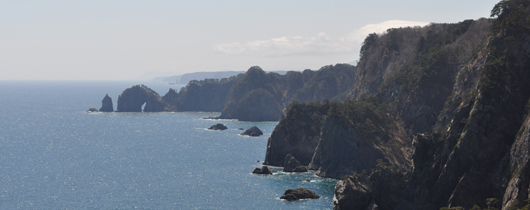
モデルコース
Page Top ▲Jyodogahama Beach
Tectonic deformation created the only coastal area in Sanriku with white serpentine rock outcrops. The white sand and rock reefs conjure the impression of the Pure Land, the beach's namesake.
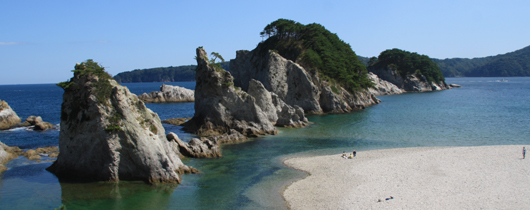
Yamada Bay
Nestled deep in a ria coastal inlet characteristic of the Rikuchu region,Yamada Bay offers serene, tranquil and scenic vistas. Yamada Bay is also famous for its oyster farms, which were destroyed during the 2011 tsunami. The industry has since recovered and is again welcoming tourists to enjoy their juicy oysters.
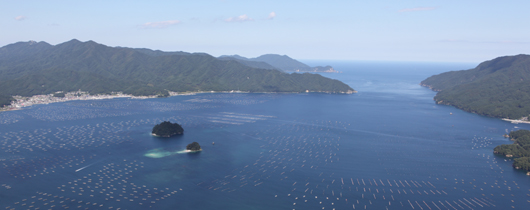
Model Course
Page Top ▲"Ama"-female divers of Kuji-
"Ama" is the name of the famous Northernmost female freedivers of Kuji, who dive into the
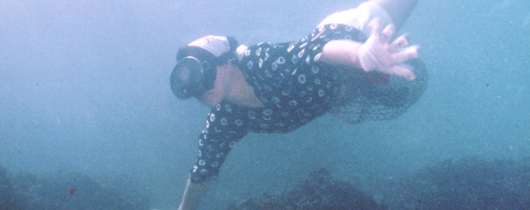
Tsunami boulders in Settai
Massive tsunami boulders from the ocean were carried inland by past and the 3.11 tsunamis, scattered all over the paddy fields of Settai. These rocks bore witness to the fury and destructive power that tsunamis can unleash, as a lesson to the future generation.
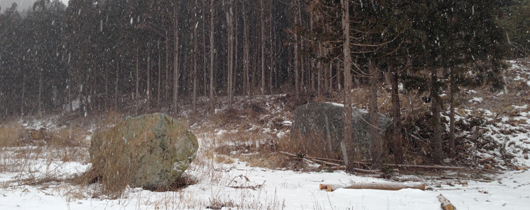
Model Course
Page Top ▲Sappa Boat
Buckle up that safety jacket and get tossed around in the "sappa boat", a small boat typically used by sea urchin and abalone fishermen. Stare in awe as the boat approaches the Kitayamazaki cliffs and enjoy the thrill as the boat closes on cliffs and zipping in and out of narrow caves.
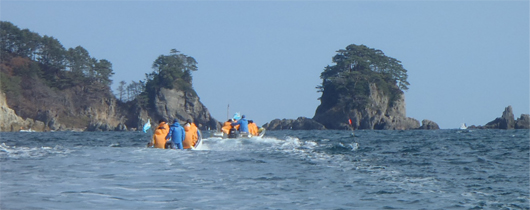
Model Course
Page Top ▲Wakame Farmer in Ofunato
The Goishi Coast area is the birthplace of Japan's wakame seaweed farming industry. Apart from tasting, do take part in some hands on work and experience the daily life of a wakame farmer.
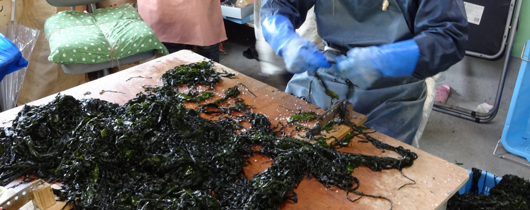
Goishi Coast
The Goishi Coast is a scenic area characteristic of the ria coast, which are drowned river valley with irregular and indented coastline. Here, we can the rocks that lent this place its namesake "goishi" , the stone pieces from the Japanese board game "go".
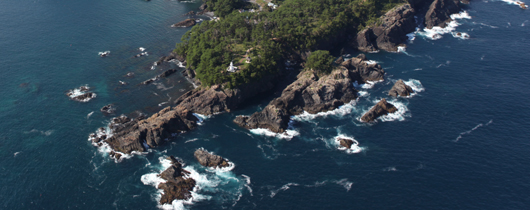
Model Course
Page Top ▲The Suneka Festival
The Suneka Festival of Yoshihama is held on the 15th January every year where locals dress up as monsters and descend from the mountains to scare "naughty kids" into behaving well that year! This festival is classified under Important Intangible Cultural Properties by the Agency of Cultural Affairs.
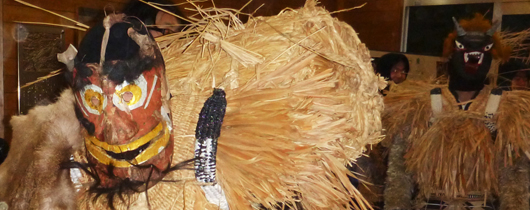
Hachinohe Sansha Taisai Festival
The biggest festival in the Hachinohe region, the Hachinohe Sansha Taisai festival is celebrated with procession of floats and "mikoshi" from the 31st July until the 4th August every year. It is now classified under Important Intangible Cultural Properties by the Agency of Cultural Affairs.
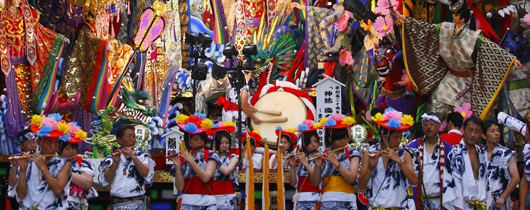
Enburi
Enburi is a folk performing art representative of the Hachinohe region that has been classified under Important Intangible Cultural Properties by the Agency of Cultural Affairs. This performance is held to pray for good harvest at the start of the year and feature "rice planting plays" and "rice planting dances".
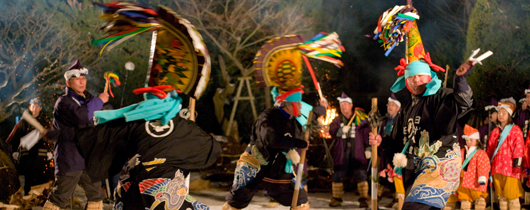
Sanriku Oki (offshore)-one of world's three richest fishery grounds-
The local fish markets are the place to enjoy and encounter varieties of seafood not available outside of this region, and at a reasonable price too! Enjoy excellent saba (mackerel), sanma (pacific saury), maguro (tuna), katsuo (bonito), karei (halibut) caught offshore and nearer to the coast, uni (sea urchins), awabi (abalone), hotate (scallops), akagai (red clam) and a variety of seaweed.
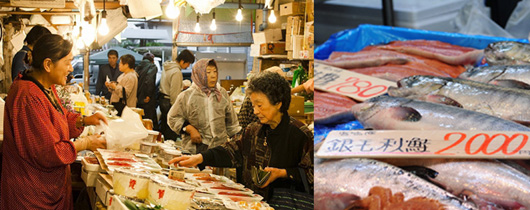
Aramaki-jake (Salmon)
Rivers in Sanriku are famous for its rich salmon and trout stock, and hosts various salmon catching festivals during summer. Choose to observe, cheer people on, or get wet and catch your own! Salmon catches are salted and dried to be made into their famous local product, Aramaki-jake which is a traditional New Year gift.
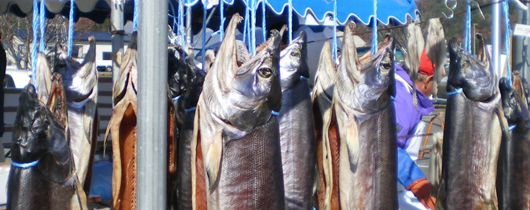
Oki-saba -mackerels from offshore Hachinohe-
Mackerels caught offshore Hachinohe are called oki-saba and are caught in the Northernmost fishing point of Japan. The low water temperature result in increased fat, and fishes packed with nutrituous EPA and DHA fatty acids and they taste extra delicious. Enjoy saba-zushi with Japanese sake in a local Hachinohe restaurant.
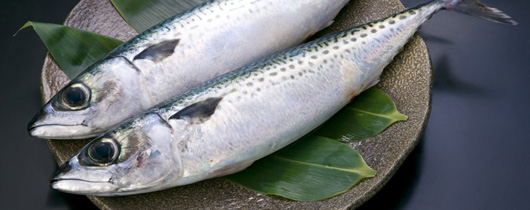
Sanriku's sea farming industry
The rugged Ria coastline with its many coastal inlets of Sanriku coast are excellent grounds for farming oysters, scallops, abalones, seaweed and other seafood. Needless to say, this is the region to enjoy the juiciest oysters and the freshest seafood not available elsewhere at reasonable prices. Or join harvesting activities and eat your own catch!
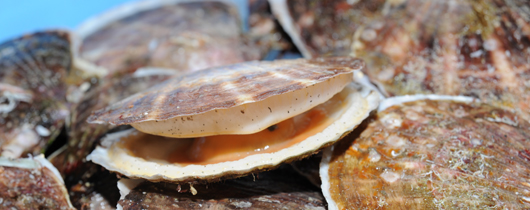
Ofunato City's Chinjyu Cuisine
The name Chinjyu came from the Camelia plant, famous in this region, and symbolizes 101 years of long life. Delicious local seafood and vegetables foraged from the mountains make up the ingredients and and perhaps the key to a its namesake.
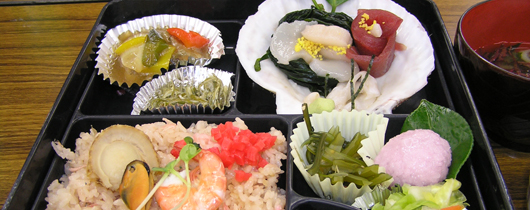
Steamed oysters at the Osakana Center, Ofunato
All-you-can-eat steamed oyster eateries are extremely popular in winter and lasts until around May every year. Best time and place to feast and also to experience harvesting oysters with local farmers. Look out for "Kaki Koya" oyster huts in Yamada Bay and Karakuwa Peninsula.
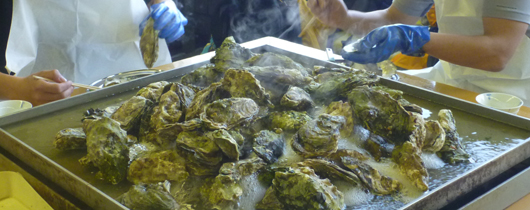
Dried persimons
Sanriku is famous for their dried vegetables, fruits and other condiments, which also feature heavily in their local cuisine. Pictured here are dried persimmons drying under the eaves of a farmer's houses, a very common and colorful scene in winter.
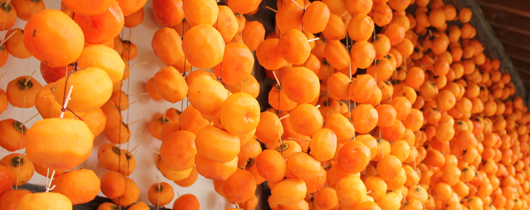
Local food products
"Michi-no-eki", rest stops along main roads are stocked with traditional local specialty dishes and snacks ready to be enjoyed while taking a break before assuming journey on Sanriku's long coastal highways. One can find local produce like local salt from Noda, wild grape products harvested from local forests and canned food made from local seafood such as their famous ichigo-ni (sea urchin and abalone soup).
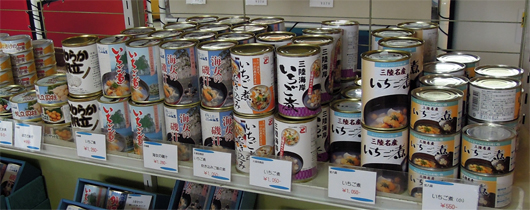 Page Top ▲
Page Top ▲
Yamada bay Oyster Festival
Yamada Bay, a calm coastal inlet is home to a thriving oyster and scallop industry famous worldwide for their juiciness, sheer size and taste. The Yamada Oyster Festival is held here every winter.
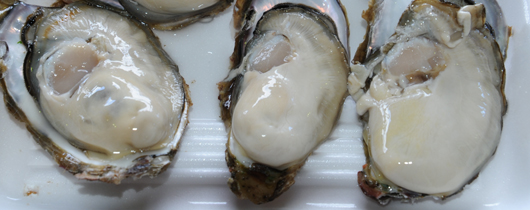 Page Top ▲
Page Top ▲
Senbei-jiru -hotpot with wheat crackers-
A unique local specialty hotpot dish using a local wheat cracker called "nambu senbei" and filled to the brim with Iwate-raised chicken, vegetables and mushrooms. A humble but heart warming soul food.
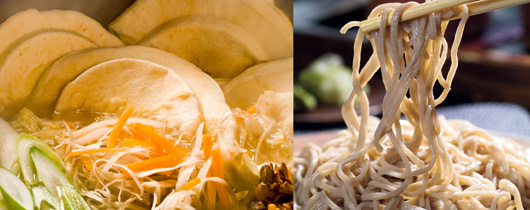 Page Top ▲
Page Top ▲
Hachinohe Tatehana Wharf Morning Market
Hachinohe is one of the three most important fishing ports in Japan, and naturally the morning markets do not disappoint. Find more than 350 stalls on a market day, which starts at dawn and closes around noon. Having breakfast at the market (early!) is one of the local culture of Hachinohe
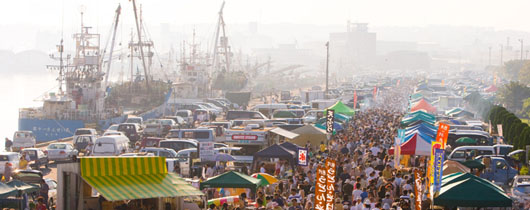 Page Top ▲
Page Top ▲
Local seafood ramen
Along the Sanriku coasts, ramen restaurants of course make their versions using the freshest local seafood of this region.
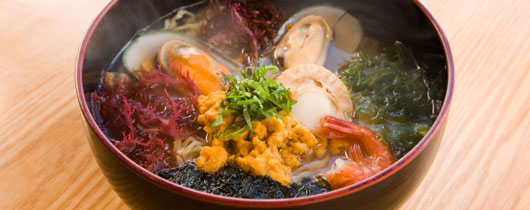 Page Top ▲
Page Top ▲
Sanriku's hallmark seafood: Uni (sea urchins) and hoya (sea pineapples)
The local Northern sea urchins are a cut above the rest in taste and size having feasted on nutrient rich kelp of the Sanriku coast. Try once and see your standards soar. Sea pineapples on the other hand, are not the most palatable at first sight, but a bite into the freshest catch in a local restaurant might make you a lifetime fan. The freshest sea pineapples (left) are eaten as sashimi, and sea urchin is the main ingredient (along with abalone) in Northern Sanriku's signature dish, Ichigo-ni.
 Page Top ▲
Page Top ▲
List of Accommodations:
National Park-related operators
〇Hachinohe Seagull View Hotel (page in Japanese)
9-19 Kofunadotai, Samemachi Hachinohe-shi, Aomori-ken Japan
〇Samurai-no-yu Kinoko-ya (page in Japanese)
133-5 Chiwari, Mukaicho Dai 7, Samuraihamacho Kuji-shi, Iwate-ken Japan
〇Kokumin-shukusha Kurosaki-sou
(page in Japanese)
84-4 Shimomura, Dai 2 Chiwari, Shimohei district, Iwate-ken Japan
〇Kokumin-shukusha Karakuwa-sou
(page in Japanese)
4-1 Karakuwacho Sakihama, Kesennuma, Miyagi-ken Japan
〇The Park Hotel Jodogahama (page in Japanese)
32-4 Hitachihamacho, Miyagi Iwate-ken, Japan
〇National Park Resort Kyukamura Rikuchu-Miyako
18-25-3,Kuwagasaki, Saki, Miyako-city,Iwate, 027-0096, Japan
〇National Park Resort Kesennuma-Ohshima
16, Sotobatake, Kesennuma-city, Miyagi, 988-0603, Japan
〇Tanesashi Campground (Hachinohe City)
55-9 Akako, Samemachi Hachinohe-shi, Aomori-ken Japan
〇Kurosaki Campground (Fudai)
Shimomura Dai 2 Chiwari, Shimohei-gun Fudai-mura, Iwate-ken, Japan
〇Kita-samuraihama Campground
Mukaicho Samuraihamacho, Kuji City, Iwate-ken Japan
〇Tsutsuji-mo-mori campground
(Mt. Hashikami, Hachinohe)
〇Tamagawa Campground (Noda-mura)
Tamagawa, Noda, Kunohe district, Iwate-ken Japan
〇Goishi Coast Campground (Ofunato City)
221-68 Ohama, Massakicho, Ofunato, Iwate-ken Japan
〇Gosaki Campground (Karakuwa)
4 Sakihama, Kawakuwacho, Kesennuma shi, Miyagi-ken Japan








